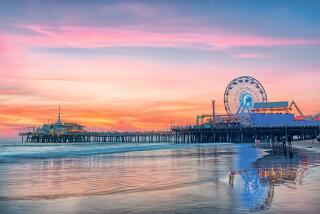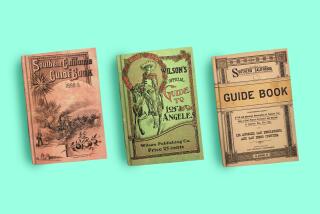The Worst Can Be a Plus for Cities Rated in ‘Places’ Index
- Share via
Alphabetically speaking, Yuba City, Calif., was used to being last on lists. But catching the caboose in Rand McNally’s “Places Rated Almanac” four years ago insulted residents right down to their toes.
At first, they fumed, they raged, they stamped their collective civic feet. Then they got smart.
City leaders decided “there are only two places to be on the list: the top--and the bottom,” said Mary Knapp, Yuba-Sutter Chamber of Commerce executive vice president. “It depends what you make of both of them.”
What Yuba made from last place was a heap of first-rate public relations hay. As city leaders reflected on how to make the best out of being the worst, they decided to lighten up.
“If you screamed and ranted and raved, you made a fool of yourself,” Knapp said. “We decided to make a fun thing of it.”
Burned Maps
First, 1,000 residents burned hundreds of Rand McNally maps at a community pep rally, packaged the ashes in a walnut box and had a local mortician present them to a Rand McNally vice president, who flew out from Chicago just for the occasion.
Then the city helped a radio station in Pittsburgh--rated No. 1 in the same survey--award an all-expense paid trip to Yuba City as a contest prize. The happy winners toured the city by limousine and rode a float in the 105th Annual Bok-Kai Festival. A good time was had by all.
And at year’s end, when Life magazine wrapped up 1985, it was Yuba City, not Pittsburgh, that received a full page. “And they spelled the name right,” Knapp said, a little amazed.
In the 50 years since one E. L. Thorndike created his “goodness index” for American cities, academicians, special interest groups, magazines and the federal government have cranked out a plethora of rankings identifying the best of all possible towns.
Stressed out? Live in State College, Pa., says one survey; Cedar Rapids, Iowa, says another.
Best place for a hip, contemporary career woman? Seattle, Savvy magazine says.
Easiest place to make friends? San Francisco, Forbes magazine says.
No. 1 overall? It’s Pittsburgh, says one survey; Danbury, Conn., says another.
In a nation where everybody loves the underdog but nobody wants to be one, where everyone says it doesn’t matter what other people think but no one believes it, city ratings have become a source of indignation, elation, frustration and, always, fascination.
Now, it’s almost time for another edition of “Places Rated,” the most objective and carefully researched of the bunch. Like the presidential election, it appears every four years--and a lot of people don’t like the results.
Lawsuits Threatened
The fallout has included threatened lawsuits, map and magazine burnings and, on a number of occasions, campaigns for civic improvements.
But ask researchers, city officials and municipal groups what city rankings mean, and how seriously to take them, and the answers seem to be not much, and not very.
“There’s no best city, just like there’s no best work of art,” said Bert Sperling, a Portland, Ore., computer researcher who, despite that opinion, created software that rates cities. “Who’s to say Van Gogh’s ‘Sunflower’ is better than (da Vinci’s) ‘The Last Supper’?”
And who’s to say there are 328 better places to live than Yuba City? Why, “Places Rated” authors David Savageau and Richard Boyer, that’s who.
But in their next “Places Rated,” Savageau and Boyer plan a section designed to make everyone happy by showing how under certain conditions, using factors in the book, any burg can be a Pittsburgh. Even last-place Yuba City.
“For instance, if the only thing you’re interested in are cities in California with a moderate climate and low cost of living,” Savageau said, “Yuba City would be the best place in the whole country.”
It took “Places Rated” not only to rocket Yuba City out of obscurity but to propel the metro ratings game onto the best-seller list.
The idea sprang from the authors’ desire to move out of Boston and their discovery that there was no single source for good, solid data on life in U.S. cities. They decided to compile a comprehensive American cities reference guide, and sold Rand McNally on the idea in 1978.
The first edition, with Atlanta at the top and Lawrence, Mass., in the cellar, came out in 1981.
More than 300,000 book sales later, Savageau says he’s a bit disappointed that the book is considered more the topic of cocktail party chitchat than the serious reference tool the authors intended, and he acknowledges that its popularity still baffles him.
“I wouldn’t go out and buy a book that said Pittsburgh was the best place in the country,” he said, taking a rare break from his computer and the latest edition of “Places Rated,” due out this fall from Simon & Schuster Inc., which acquired the series last year from Rand McNally.
When the statistics laid the exalted mantle of extreme livability on Pittsburgh, a city once known as “hell with the lid off,” even Rand McNally didn’t believe it at first.
The crowning of Pittsburgh illustrates the key difference between “Places Rated” and other city rankings.
The Savageau-Boyer study gives equal weight to climate, housing, crime, transportation, health care, recreation, education, the arts and economics. That might tend to give an edge to larger cities, which have more amenities, and doesn’t take into account which factors people think are most important.
Other studies tend to focus on one aspect of life, such as relief from stress--which the advocacy group Zero Population Growth found in Cedar Rapids and a study in Psychology Today magazine found in State College.
Or they consider the preferences of a specific group of people, as Money magazine does, polling 251 subscribers. In its 1987 survey, Pittsburgh was 43rd; Nashua, N.H., was No. 1. Last year, Pittsburgh moved to No. 20; Danbury, Conn., was top of the heap.
A change from one year to the next in what the subscribers consider most important--say, education over leisure, or transportation over weather--plus even a small shift in a city’s vital statistics can account for a wild fluctuation, said Sperling, whose company, Fast Forward, has created a computer program called “Places U.S.A.” used by Money.
“Some of the cities that have been disappointingly rated have used it to say, ‘Oh, yeah?,’ and show they have a strong community support base,” said Randy Arndt, spokesman for the National League of Cities. “It depends on the resourcefulness of the city.”
The league wouldn’t dream of ranking its 1,400 members. “I don’t know who these surveys benefit, except the authors. Everybody doesn’t live in the perfect place, but it’s home to us,” Arndt said. “Whether you live in Scarsdale or Saginaw, life is what you make of it.”
More to Read
Sign up for Essential California
The most important California stories and recommendations in your inbox every morning.
You may occasionally receive promotional content from the Los Angeles Times.













